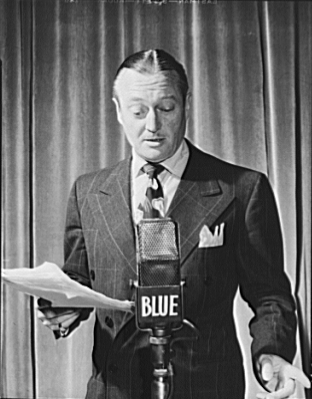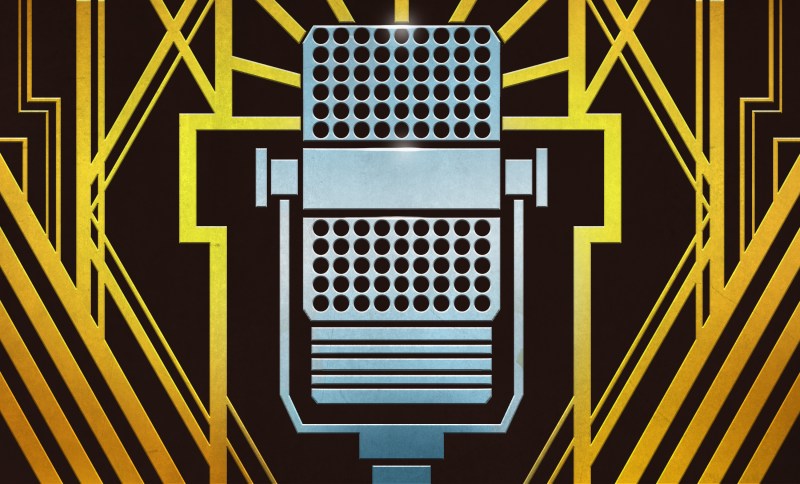 If you’ve ever seen an old movie or TV show where there was a radio announcer, you’ve probably seen a ribbon microphone. The RCA 44 (see Edmund Lowe, on right) had exceptional sound quality and are still valued today in certain applications. The name ribbon microphone is because the sound pickup is literally a thin strip of aluminum or other conductive material.
If you’ve ever seen an old movie or TV show where there was a radio announcer, you’ve probably seen a ribbon microphone. The RCA 44 (see Edmund Lowe, on right) had exceptional sound quality and are still valued today in certain applications. The name ribbon microphone is because the sound pickup is literally a thin strip of aluminum or other conductive material.
Unlike other common microphones, ribbons pick up high frequencies much better due to the high resonant frequency of the metallic ribbon. This is not only better in general, but it means the ribbon mic has a flatter frequency response even at lower frequencies. Another unique feature is that the microphone is bidirectional, hearing sounds from the front or back equally well. It is possible to build them with other directional patterns, although you rarely see that in practice.
Invention
In the early 1920s, Walter Schottky and Erwin Gerlach developed the ribbon microphone (and, coincidentally, the first ribbon loudspeaker). Harry Olson at RCA developed a ribbon mic that used coils and permanent magnets which led to the RCA Photophone Type PB-31 in 1931. Because of their superior audio response, they were instant hits and Radio City Music Hall started using the PB-31 in 1932. A newer version appeared in 1933, the 44A, which reduced reverberation.
The BBC and Marconi also made similar microphones including the Type A and the Coles 4038. The Russian version was the Oktava. Although the technology is nearly one hundred years old, many sound engineers still use ribbons because of the fidelity of the recording.
Much of what motivated Olson was recording sound for movies. The sharp directional characteristics of the ribbon were helpful when recording for motion pictures. Noisy cameras could be hidden at the sides of the ribbon microphone, and would be mostly left out of the recording.
How it Works
The ribbon mic is actually just another form of dynamic microphone. A conventional dynamic mic uses a moving coil as a transducer. Of course, the sound has to move the coil, and there is a definite limit to how light you can make the coil.
In a ribbon mic, the ribbon acts as a transducer, of course. The microphone suspends the ribbon between the poles of a permanent magnet. As the ribbon vibrates, the motion and the magnetic field generate a voltage measured by two contacts, one at either end of the ribbon.
Proponents of the ribbon microphone claim that the mechanism is closer to how your ears work, which makes them sound better. The output voltage is generally low compared to a traditional dynamic microphone, necessitating a transformer. However, modern designs often use improved magnets and transformers that can meet or exceed the output voltage of a typical microphone.
About the only downside to the ribbon is it is relatively fragile. Loud instruments (like drums) can damage the ribbon. Even wind can stretch or tear ribbons. Most modern ribbon microphones can handle phantom power intended for dynamic mics, but some can take damage from power on the signal lines.
The video below shows the construction of a modern ribbon microphone.
Ribbons Today
 Many singers and musicians appreciate working with ribbon microphones, even today. Everyone from Frank Sinatra (left) to Elvis Presley sang into them, and they are still popular with certain artists and recording engineers.
Many singers and musicians appreciate working with ribbon microphones, even today. Everyone from Frank Sinatra (left) to Elvis Presley sang into them, and they are still popular with certain artists and recording engineers.
You can still buy ribbon microphones. In fact, inexpensive imports allow even budget-conscious audiophiles to record using a ribbon microphone. Companies like AEA, Royer Labs, Crowley & Tripp, and many others still make this type of microphone. Some use stronger materials for the ribbon or have different ways of securing it. Some have integrated amplifiers instead of, or in addition to, transformers. Some of those amplifiers even use tubes if you subscribe to the idea that tubes sound better.
A professional instrument can cost thousands of dollars, but others cost well under $100. Original RCA mics are still prized and usually quite expensive. A very serviceable mic should run you no more than $200.
If you want to hear a comparison of a dynamic, a condenser, and a ribbon microphone, check out the video below. You may or may not think the ribbon mics sound better, but you can certainly tell the difference between the three types with your ears.
















I’m curious which one sounds best to other people listening to this video? Or if you find there is a best, even?
Personally, the Sure Beta 52 wins this contest. Some others come close, others sound like mud.
Disclaimer: I know nothing about mics or recording, and the only mics I own are built into my computers and phones. If it matters at all, I listened to the video on my (looks at ear cans…) audio-technica ATH-M30 headphones.
The answer is really “it depends.” The Beta 52 has a noticeably “peaky” response that is suited for bringing out the click from a kick drum beater. A great mic for a solo instrument might not be the best when the instrument is used in a dense mix. I’m partial to anything in the AT40xx series, they’re real workhorses.
@B
“If it matters at all” haha, yes, it matters. :) You can’t compare microphones if the differences happen to lie in frequencies the speakers don’t reproduce well. Though using the same for both is certainly better than having *two* uncontrolled variables.
Which reminds me of a time I stumbled on a forum thread where folks were discussing what brand and color of paint best replicated the colors used on some particular WW2 tank. People were making posts like “that’s not right at all; *this* is the color you want” and then a cell phone picture taken in a room lit by incandescent bulbs showing a page in a book with a 1940s Kodachrome photo. D:
lol, I know right?
Human brains see colour as relative. There’s some amusing demonstrations you can do, with RGB lighting control, and surfaces with coloured stuff painted on them.
Anyway, my point is, for a picture of a tank, in daylight, in typical surroundings, with grass and sky, etc, for contrast, you probably could tell what colour it should be, or at least what colour would look the same to a human.
I wasn’t very fond of the Beta 52 at all, actually; it sounded almost like someone had run the audio through a 64kbps MP3, or some kind of speech filter.
As far as the ribbon mics go, I liked the sound of the Beyer M500, personally. All the others had much too little response in the highs for my taste. On that note, it seems like the size of the ribbon has a much more definite effect on frequency response than the size of the element in the dynamic and condenser mics.
I was really surprised at how muddy all of the ribbon mics sounded, except for the Beyer, which had too much hi-freq and very little bass, no presence. I think the Beta 87 condenser had better overall response, but it was still a bit muddy (it’s really more of a vocal mic, though). I thought the best sound, clearest highs and best range overall was the EV650 dynamic. The Beta 52 was awful, but since it’s really meant to be a kick mic, I’ll cut it some slack.
Almost to a mic, the large-diaphragm condensers using the omnidirectional pattern were better than any of the other configurations of the same mics; they picked up the high-frequency sound of the high strings and the pick much better (and the bidirectional pattern on a couple was kinda muffled). Outside of the omnis, the Beyer, the EV650, and the AKG 451, everything else was too muddy, and in a busy mix the guitar would get lost because there was no high-frequency distinctness to cut through.
The problem here is that you don’t know how “muddy” that particular guitar sounds like to begin with, so there’s no comparison in what it should sound like.
Maybe all the “clear” sounding mics were simply over-emphasizing and the ribbon mics were in fact more true to life. Another effect is the pattern of the mic – where it’s pointed at on the guitar – highly directional mics are prone to pick up the sound from the strings more than from the ambient room which damps the higher frequencies.
For an effect, just listen to the video and with every muddy mic, cup your earlobes a bit forward towards the speakers. Surprise – it sounds brighter because you’re changing your own “mic pattern” to exclude the lower frequency sounds from elsewhere in the listening space.
I Agree. My experience with ribbons is that they lack brightness. It is interesting that the post claims ribbons are known for good high frequency response.
And they are easy as hell to break-at least the old ones (although I have been fixing a lot of Heils lately). I feel like they have a place-like in a studio vault in their cushioned cases and on ebay. There are far better mics that don’t suffer these mics shortcomings but hey folks have opinions…
The muddiness mainly comes into play when you have hi freq coming in along with the low so it gets burned off in the hi’s fluttering. They are decent room mics I guess.
Good != Loud
The high frequency response of ribbons is typically quite low, but it’s a very flat, smooth top end compared to the much more peaky top end of many condenser microphones. You have to EQ it up but they take EQ beautifully because of this.
The Electro-Voice 660, the AKG 820, and the Beyer M500. Because those sound like I can hear all 6 strings separately (even after YouTube compression and a cell-phone speaker). With different speakers I’m certain I’d have a different opinion. But mostly, they sound like what I would want the raw sound to sound like.
TL/DL (Too long, didn’t listen.)
Since you ask, yes the shure ones sound smoother for music but less exact, except the shure you mentioned seems to go more exact while still retaining the musically pleasing sound.
Although it’s true that it probably depends i the end to what you are recording, a group of instruments or the human voice might sound better with other ones.
But, since I sort of like exactness I do like some of the AT ones, since they are less smoothed out it seems.
However in the end if I needed something recorded professionally I’d leave it to the audio engineer since I would find it hard to decide and there’s too many choices and factors for me to keep interested in the details.
And while I’m typing, I don’t like it when the low sound of the guitar reverberates too much, even when if you hear a guitar live that is audible to your ears like that too, but I like a recording to tone that down a bit.
Oh and disclaimer: I know shit-all about music and I’m not really into music.
First you are hearing at most a 196k AAC stream of audio. Good but not audition worthy. Not even for one voice on a mic.
I have 2 birdcage mics, getting close to one you can get warm and wonderfully rich. With my bass range I can get that satisfying sound now gone from the Fred Childs of NPR, where they modulate up frequently and come off like kindergarten teachers or golf announcers at a funeral.
They have dropped the standards of good voice work inspired by these microphones, more like Peter Van De Graff on WFMT.
That one female announcer that does all the underwriting credits on NPR is the worst.
The worst on radio are people who have a buzz in their voice with just the right characteristics that cause the equipment to excessively amplify it – causing terrible distortion on the receiving end that threatens to destroy speakers.
I hate it when they interview people but drink coffee and so answer ‘mmm’-so insanely unprofessional. Totenberg is perhaps the worst offender of this…
196K AAC is not enough for a freaking voice? 64K would be enough for a voice. Hell 32K would probably be enough for the human voice.
32K Is dramatic overkill for a voice. Go look up Codec2 and FreeDV :P
(FWIW, I think the other guy meant “voice” as in one recording channel)
And you need FAR less to transmit understandable voice. Chop off everything below 300 Hz and above 3400 Hz. And compress the bejesus out of what is left. But understandability of voice is a can of worms you don’t want to deal with if you don’t have too, trust me.
Also don’t underestimate those new fangled mems microphones, their response is flat as a pancake. And cheap.
My impression is that we are hearing too much of the sound hole ‘sound’ and it is dominating the rest of the guitar sound and making it harder to hear the differences in microphone responses.. Positioning the microphone opposite the join of the guitar neck to the body (rather than opposite the sound hole) is the usually recommended set-up for a single microphone. Mind you, the sound balance in the recording was probably exactly what was wanted so I’m not going to argue.
The YouTube description does note that the ribbon mics sound awful with this particular placement. Except the Beyer M500, which was the only mic apart from the omnis that I heard any fret noise on.
PS. Am I the only one who noticed the error about “phantom power intended for dynamic mics”? :)
Yes, mic position means a lot and agree with Johns comment on “hole sound”. I also noticed that the position of the capsules in relation to the guitar varies as much as 2 inches which is huge and can change how the guitar sounds. A number of the ribbon mics were sounding over-driven which will change their response. Nonetheless for the condenser & dynamic mics it seemed a pretty good demonstration. I would like to hear the ribbons again with a more optimal mic placement.
Therefore;
a whine is like wine!
B^)
In a somewhat recent issue QST featured a hams ribbon microphone build. July 2014 page 42
DIY ribbon microphones are fairly common, as it’s the only practically useful microphone that you can DIY with hobbyist-available equipment…
Apart from fiddling with the ribbon, it’s not even that hard to make :D
Ribbons have there resonance around 10-30Hz. The RCA44 and AEA’s ribbons are tuned at 17.5Hz.
Cost relates to quality on a log scale?
“Most modern ribbon microphones can handle phantom power intended for dynamic mics, but some can take damage from power on the signal lines.”
Phantom power is intended for condenser mics, dynamic mics are passive while condenser mics have onboard circuitry to amplify the weak output of the mic capsule, as well as the capsule itself needing to be charged in most cases…
…and ribbons will only take damage from phantom power if they’re unbalanced. I’ve never heard of anyone making an unbalanced ribbon mic and given their relatively low output I don’t see why anyone would want to introduce more noise by unbalancing the output (dynamic microphones are naturally ballanced – each end of the voice coil or ribbon will be the opposite of the other). Since both signal lines have the same voltage applied, no current flows and no magnetic field is generated, which is what would destroy the ribbon.
Faulty cables that short one of the pins to ground, or TRS patch bays where one side is connected before the other, on the other hand, ~they~ can destroy a ribbon mic with phantom power applied.